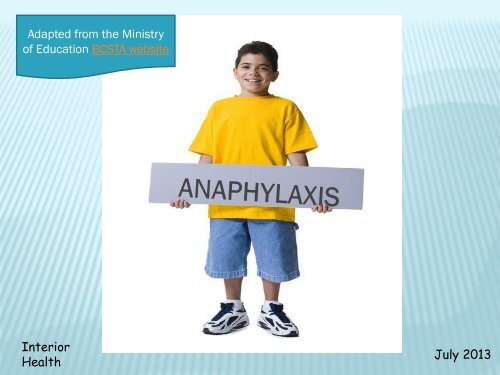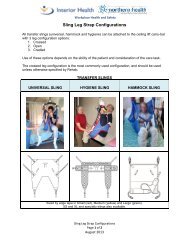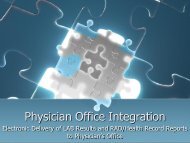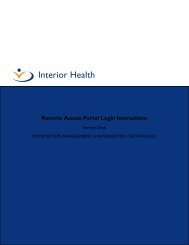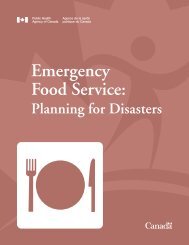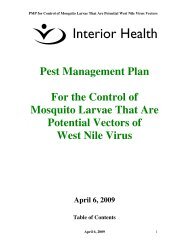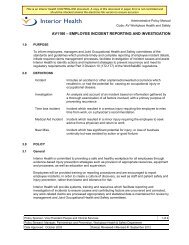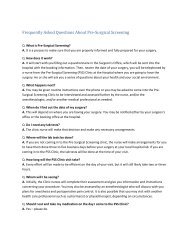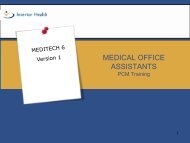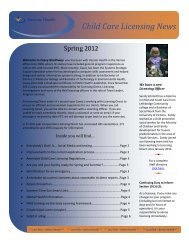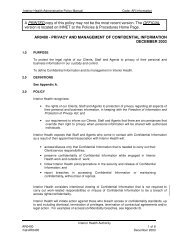Allergies and Anaphylaxis Powerpoint Presentation - Interior Health
Allergies and Anaphylaxis Powerpoint Presentation - Interior Health
Allergies and Anaphylaxis Powerpoint Presentation - Interior Health
Create successful ePaper yourself
Turn your PDF publications into a flip-book with our unique Google optimized e-Paper software.
Adapted from the Ministry<br />
of Education BCSTA website<br />
<strong>Interior</strong><br />
<strong>Health</strong><br />
July 2013
WHAT IS AN ALLERGY<br />
<strong>Allergies</strong> occur when the immune system becomes<br />
unusually sensitive <strong>and</strong> overreacts to common<br />
substances that are normally harmless. Examples are:<br />
Foods – peanuts, tree nuts, sesame seeds, milk<br />
eggs, seafood, soy, wheat, sulphites <strong>and</strong> mustard<br />
Insect bites – bees, wasps, hornets <strong>and</strong> some ants<br />
Medications – penicillin, sulfa drugs<br />
Exercise<br />
Latex – gloves/medical devices<br />
Reference: <strong>Anaphylaxis</strong> Canada (2013) 2
WHAT IS ANAPHYLAXIS<br />
Occurs when a person is exposed to an allergen<br />
causing a severe, life-threatening allergic response<br />
Reactions occur within minutes or, more rarely, up to<br />
a few hours after exposure<br />
Reference: <strong>Anaphylaxis</strong> Canada (2013)<br />
3
COMMON SYMPTOMS<br />
Skin – hives , swelling, itching, warmth,<br />
redness, rash<br />
Respiratory (breathing) – wheezing, shortness<br />
of breath, throat tightness, cough, hoarse voice,<br />
chest pain/tightness, nasal congestion or hay<br />
fever-like symptoms (runny itchy nose <strong>and</strong><br />
watery eyes, sneezing), trouble swallowing<br />
Reference: <strong>Anaphylaxis</strong> Canada (2013) 4
Swollen lips/face <strong>and</strong><br />
hives present<br />
www.sovereign-publications.com/.../ANAPHYL.jpg<br />
5
COMMON SYMPTOMS<br />
Gastrointestinal (stomach): nausea,<br />
pain/cramps, vomiting, diarrhea<br />
Cardiovascular (heart): pale/blue colour, weak<br />
pulse, passing out, dizzy/lightheaded, shock<br />
Other: anxiety, feeling of “impending doom”,<br />
headache, uterine cramps in females, metallic<br />
taste<br />
Reference: <strong>Anaphylaxis</strong> Canada (2013) 6
MOST DANGEROUS SYMPTOMS<br />
Trouble breathing caused by airway swelling<br />
A drop in blood pressure causing dizziness,<br />
light-headedness, feeling faint or weak, or<br />
passing out<br />
Reference: <strong>Anaphylaxis</strong> Canada (2013)<br />
7
Anaphylactic Reaction<br />
Normal Appearance<br />
Hives <strong>and</strong> Swelling of face<br />
Important: Not all reactions have hives<br />
www.natureshomoeo.com.au/image/student.JPG<br />
8
health.yahoo.com/media/healthwise/h9991075.jpg<br />
9
WHY ARE TEENS AT HIGHER RISK<br />
Increased independence<br />
Increased risk taking<br />
<br />
Eating unsafe food <strong>and</strong> eating out<br />
Not carrying auto injector,<br />
The part of the brain that makes decisions is the<br />
last to mature<br />
Not telling friends, wanting to fit in<br />
http://www.allergysafecommunities.ca/challenges/<br />
Reference: Allergy Safe Communities (2013)<br />
10
PREVENTION = HAVING A PLAN<br />
Ensure the medical alert list is up-to-date <strong>and</strong> familiarize yourself<br />
with students who have medical conditions <strong>and</strong> allergies<br />
Review emergency care plans for each student<br />
Note where auto-injectors are stored for each student. Ensure<br />
auto-injectors are immediately available<br />
Recognize allergy sources <strong>and</strong> triggers<br />
Know when <strong>and</strong> how to administer the auto-injector<br />
Prepare for outdoor <strong>and</strong> off school grounds activities<br />
<strong>Anaphylaxis</strong> Awareness/Avoidance Strategies <strong>and</strong> Checklist 11
WHAT SHOULD I DO<br />
1. Administer single dose auto-injector<br />
2. Call 911<br />
3. Notify parent/guardian<br />
4. Administer second auto-injector in<br />
5 to 15 minutes after first dose is given IF<br />
symptoms do not improve or if symptoms recur<br />
5. Have ambulance transport student to hospital<br />
*Epinephrine is the only way to reverse the effects<br />
of anaphylaxis. Give ASAP<br />
**Remember, the epinephrine may only last for 15<br />
minutes, calling 911 is very important<br />
Reference: BC Anaphylactic <strong>and</strong> Child Safety Framework (2007) 12
WHAT SHOULD I DO<br />
<br />
<br />
When in doubt, administer epinephrine. Symptoms<br />
of anaphylaxis can be as simple as tingling of the lips<br />
or as severe as cardiac arrest.<br />
If a person says they are having a reaction it is<br />
important to believe them, <strong>and</strong> immediately<br />
administer epinephrine regardless of the symptoms<br />
present<br />
<br />
Antihistamines <strong>and</strong> asthma medication must not be<br />
given as first line treatment for anaphylaxis<br />
13
WHAT IS AN EPINEPHRINE AUTO-<br />
INJECTOR<br />
An auto-injector is an easy way to give epinephrine to<br />
someone having an allergic reaction<br />
There are three auto-injectors available in BC:<br />
Allerject TM<br />
EpiPen®<br />
Twinject®<br />
14
WHAT IS AN EPIPEN ® <br />
A disposable, pre-filled automatic<br />
injection device that administers<br />
a single dose of epinephrine<br />
Reference: www.epipen.ca<br />
15
HOW TO USE EPIPEN ® <br />
<br />
<br />
Hold firmly with ORANGE tip pointing downward.<br />
Remove BLUE safety cap by pulling straight up.<br />
Do not bend or twist.<br />
<br />
<br />
<br />
Swing <strong>and</strong> push ORANGE tip firmly into midouter<br />
thigh until you hear a “click.”<br />
Hold on thigh for several seconds.<br />
EpiPen video link<br />
Built-in needle protection<br />
When EpiPen ® is removed, the ORANGE<br />
needle cover automatically extends to cover<br />
the injection needle, ensuring the needle is<br />
never exposed.<br />
Reference: www.epipen.ca<br />
16
WHAT IS ALLERJECT TM <br />
A disposable, pre-filled<br />
automatic injection<br />
device that administers a<br />
single dose of<br />
epinephrine<br />
Talks users through each<br />
step<br />
Reference: www.allerject.ca<br />
17
HOW TO USE ALLERJECT TM <br />
•youtube demonstration link<br />
•Pull Allerject from the outer case<br />
•Pull off RED safety guard<br />
•To reduce the chance of an accidental<br />
injection, do not touch the BLACK base of the<br />
auto-injector, which is where the needle<br />
comes out<br />
•Place BLACK end against the middle of the<br />
outer thigh, then press firmly <strong>and</strong> hold in place<br />
for five seconds<br />
•Do not inject into any other location<br />
•Once the injection is complete, replace the<br />
outer case<br />
Reference: www.allerject.ca 18
WHAT IS TWINJECT ® <br />
•A disposable, pre-filled automatic<br />
injection device that contains two<br />
doses of epinephrine in a single device<br />
•First dose of epinephrine is<br />
administered by auto-injection, just like<br />
the EpiPen® <strong>and</strong> Allerject TM<br />
**Remember, staff are not<br />
recommended to give dose two<br />
(manual intramuscular injection of<br />
epinephrine)<br />
Reference: www.twinject.ca 19
FOR INFORMATION ONLY: HOW TO<br />
USE TWINJECT ® <br />
<br />
Pull off GREEN end cap labeled “1”. Never put<br />
thumb, finger or h<strong>and</strong> over the RED tip.<br />
Pull off GREEN end cap labeled “2”<br />
<br />
Press RED cap into outer thigh until unit<br />
activates. Hold Twinject® in place for about 10<br />
seconds<br />
<br />
video link<br />
20<br />
Reference: www.twinject.ca
WHAT TO DO AFTER GIVING<br />
EPINEPHERINE<br />
• If dizzy or faint have student lie still on his or her back<br />
with feet higher than the head<br />
• If nauseous or vomiting, have the student lie on their<br />
side to prevent choking<br />
• If breathing is difficult, have the student sit up<br />
• Loosen tight clothing <strong>and</strong> cover student with<br />
blanket<br />
• Don’t give anything to drink<br />
• Send auto-injector with student to hospital<br />
21
CONCLUSION:<br />
FOLLOW THE THREE A’S<br />
Awareness<br />
Know the triggers<br />
Know the emergency plan <strong>and</strong> how to administer<br />
epinephrine via the auto-injector<br />
Avoidance<br />
Avoid contact with allergens, make classrooms safe<br />
Action<br />
Give auto-injector <strong>and</strong> call 911.<br />
Don’t delay!<br />
22
RESOURCES<br />
For more information contact your Public <strong>Health</strong> Nurse <strong>and</strong> see:<br />
www.bced.gov.bc.ca/health/bc_anaphylactic_child_safety.pdf<br />
(BC Anaphylactic <strong>and</strong> Child Safety Framework)<br />
www.anaphylaxis.org (<strong>Anaphylaxis</strong> Canada)<br />
www.whyriskit.ca/pages/en/home.php (Why Risk It- Teens)<br />
www.aaia.ca (Allergy/Asthma Information Assoc.)<br />
www.allerject.ca (Allerject®)<br />
www.epipen.ca (EpiPen®)<br />
www.twinject.ca (Twinject®)<br />
www.medicalert.ca Medic Alert<br />
www.bchealthguide.org/healthfiles <strong>Health</strong> files<br />
https://dsweb.bcsta.org/docushare/dsweb/View/Collection-<br />
7655 BC Ministry of Education Core <strong>Anaphylaxis</strong> Resources<br />
23
REFERENCES<br />
<strong>Anaphylaxis</strong> Canada (2013)<br />
http://www.anaphylaxis.org/<br />
AAIA <strong>Anaphylaxis</strong> Reference Kit (2007) by the Allergy<br />
<strong>and</strong> Asthma Information Association, <strong>Health</strong> Canada<br />
<strong>Anaphylaxis</strong> in Schools & Other Settings (Second<br />
Edition, 2009) by the Canadian Society of Allergy <strong>and</strong><br />
Clinical Immunology.<br />
Allergy Safe Communities. (2013)<br />
http://www.allergysafecommunities.ca/<br />
24
ANY QUESTIONS<br />
25


